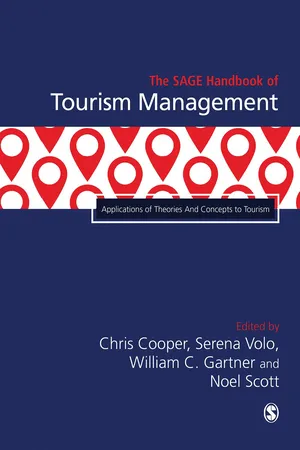
The SAGE Handbook of Tourism Management
Applications of Theories And Concepts to Tourism
- 616 pages
- English
- ePUB (mobile friendly)
- Available on iOS & Android
The SAGE Handbook of Tourism Management
Applications of Theories And Concepts to Tourism
About this book
The SAGE Handbook of Tourism Management is a critical, state-of-the-art and authoritative review of tourism management, written by leading international thinkers and academics in the field. With a strong focus on applications of theories and concepts to tourism, the chapters in this volume are framed as critical synoptic pieces covering key developments, current issues and debates, and emerging trends and future considerations for the field.
Part One: Approaching Tourism
Part Two: Destination Applications
Part Three: Marketing Applications
Part Four: Tourism Product Markets
Part Five: Technological Applications
Part Six: Environmental Applications
This handbook offers a fresh, contemporary and definitive look at tourism management, making it an essential resource for academics, researchers and students.
Frequently asked questions
- Essential is ideal for learners and professionals who enjoy exploring a wide range of subjects. Access the Essential Library with 800,000+ trusted titles and best-sellers across business, personal growth, and the humanities. Includes unlimited reading time and Standard Read Aloud voice.
- Complete: Perfect for advanced learners and researchers needing full, unrestricted access. Unlock 1.4M+ books across hundreds of subjects, including academic and specialized titles. The Complete Plan also includes advanced features like Premium Read Aloud and Research Assistant.
Please note we cannot support devices running on iOS 13 and Android 7 or earlier. Learn more about using the app.
Information
1 An Introduction to The Handbook
- The development of the field – key milestones, literature, methodologies, events and writers involved;
- The framing of the field – the current state of the art/thinking and a clearly legible mapping of the field into main areas of study. In other words, a comprehensive and timely discussion of where the literature is now, and why;
- Emerging issues and a future-focused agenda for the field, including any methodological issues; and
- A comprehensive reference list is provided in each chapter.
Part I Approaching Tourism
2 The Mobilities Paradigm and Tourism Management
Introduction
Table of contents
- Cover
- Half Title
- Title Page
- Copyright Page
- Contents
- List of Figures
- List of Tables
- Notes on the Editors and Contributors
- 1 An Introduction to The Handbook
- Part I Approaching Tourism
- 2 The Mobilities Paradigm and Tourism Management
- 3 Critical Turns in Tourism Studies
- 4 Tourism for Poverty Alleviation: Issues and Debates in the Global South
- 5 Tourism Gender Studies
- 6 Tourism Education and Scholarship
- 7 Human Rights, Disabilities and Social Tourism: Management Issues and Challenges
- Part II Destination Applications
- 8 Destination Competitiveness
- 9 Destination Management
- 10 Tourism in Emerging Markets
- 11 Destination Marketing Organisations
- 12 Tourism Crisis and Safety Management
- Part III Marketing Applications
- 13 The Development of Service-Dominant Logic within Tourism Management
- 14 Tourism Products and Experiences
- 15 Tourism Destination Image
- 16 Destination Branding
- 17 Consumer Behaviour in Tourism
- 18 Understanding and Satisfying Consumer Needs: Segmentation, Targeting and Positioning
- 19 Tourism Distribution and Intermediaries
- 20 Critical Developments in Revenue Management and Pricing
- Part IV Tourism Product Markets
- 21 Contemporary Perspectives on Visitor Attractions
- 22 The Creative Economy, Entertainment and Performance
- 23 Hospitality Management
- 24 Niche Tourism: Past, Present and Future
- 25 The Growth and Development of Leisure Events and Festival Tourism
- 26 Business Events
- Part V Technological Applications
- 27 Tourism and the Internet: Marketing Perspectives
- 28 Tourism and Social Media
- 29 The Potential of Tracking Technologies, Smartphones and Sensors for Tourism Management and Planning of Destinations
- 30 The Future Is Now: How Virtual Reality and Augmented Reality Are Transforming Tourism
- 31 Framing Tourism Futures Research: An Ontological Perspective
- Part VI Environmental Applications
- 32 Managing the Natural Environment for Tourism
- 33 Tourism and Specific Localities: Mountains, Deserts and Coasts
- 34 Managing Built Heritage Resources
- 35 The Host Community: Perceptions of and Responses to Tourism
- 36 Tourism in a Low Carbon Energy Future
- 37 Tourism and Corporate Social Responsibility
- Index